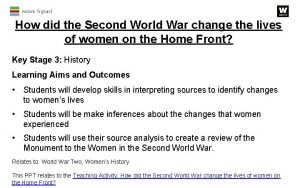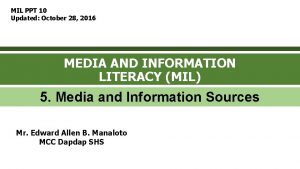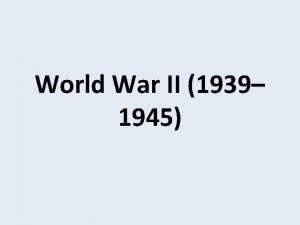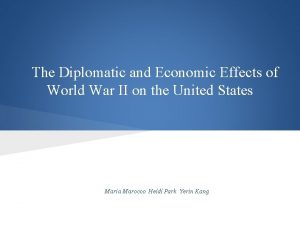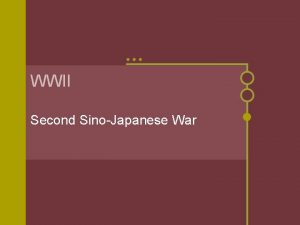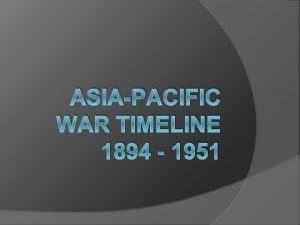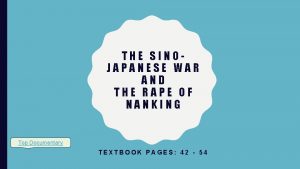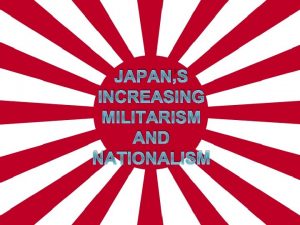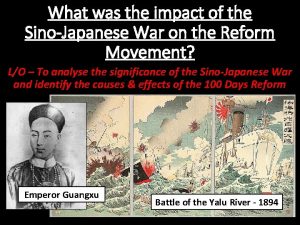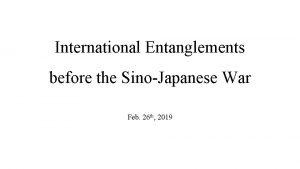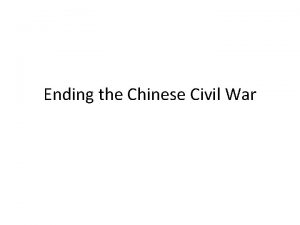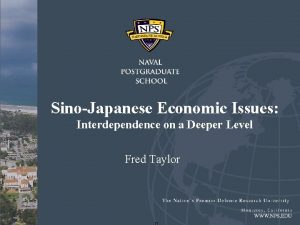SECOND SINOJAPANESE WAR Nina Matkava May 4 th















- Slides: 15

SECOND SINO-JAPANESE WAR Nina Matkava May 4 th

BACKGROUND v. Two empires, two independent countries v. Japan v. China v“War of Aggression” v. July 7, 1937 – September 9, 1945 v. Marco Polo Bridge near Beijing, in a province called Warping

RESEARCH QUESTIONS 1. How did the war between those two great nations emerge? 2. What was the reason behind the second Sino-Japanese War? 3. What was China’s position on internal and foreign affairs? 4. What served as a cause of Japan’s defeat?

LEADING FACTORS v. Japan’s strong will to become regional hegemony v. Resources v. Weak China – great time to act v. Power/Authority

SIGNIFICANCE OF THE WAR / THESIS STATEMENT v Number of important reforms v Economic structural changes v Political reform v Battles and protests “The Significance of this war lies in the number of reforms, economic structural changes and political outcomes, due to different battles and protests taking place during those times in both nations. ”

JAPAN V. CHINA

ü 21 regular divisions of 462, 000 well organized, well-trained officers and soldiers ü 1. 5 million trained men in reserve ü 2. 5 million partly trained forces üExtra forces – additional Manchurian, Mongolian, and Chinese puppet troops

ü Weak military ü Torn apart between CCP (China’s Communist Party) and the nationalist Guomindang

CHINA’S INTERNAL AFFAIRS § Poor internal sovereignty § National Crisis § Struggle between maintaining the same regime and establishing democratic government § Eight Principles

8 MAIN PRINCIPLES. . . 1. Delineation of Authority and 5. Improvement in personnel Responsibility between the administration Central Government and the Local Government 2. 3. Institution of Joint Provincial 7. Implementation of Land Policy Office System 8. Special Administrative Promotion of Experimental Inspector System Hsien 4. 6. Maintenance of Local Security Initiation of New Hsien System

FOREIGN AFFAIRS üMoral support from People of Nations towards Chinese foreign policy üBanned trade with Japan üInternational Anti-Aggression Campaign

üConferences: v. World Conference to save China in London, United Kingdom (35 Nations) v. Anti. Bombing Conference in Paris, France (35 Nations)

JAPAN’S SURRENDER q External Powers q Atomic-bomb on Hiroshima (August 6, 1945) q 3 days later Soviet Union attacks the Japanese in Manchuria q August 9, 1945 – Another atomic-bomb on Nagasaki q August 15, 1945 – Emperor Hirohito officially surrenders to the Allies q Signed on September 2, 1945 q Japanese forces in China surrendered officially on September 9, 1945

CITATION v Dorn, Frank. The Sino-Japanese war: 1937 -1941; from Marco Polo bridge to Pearl Harbor. New York: Macmillan, 1974. v Citation: Hu, Puyu. A brief history of Sino-Japanese war (1937 -1945). Taipei, Taiwan: Chung Wu Publishing Co. , 1974. v Hsiao-pei Y. Frontier Anthropology and Chinese Colonialism in the Southwestern Frontier during the Second Sino-Japanese War. Boundary 2 [serial online]. May 2017; 44(2): 157 -186. Available from: Academic Search Complete, Ipswich, MA. Accessed May 4, 2017. v Goodman D. Reinterpreting the Sino–Japanese War: 1939– 1940, peasant mobilisation, and the road to the PRC. Journal Of Contemporary China [serial online]. January 2013; 22(79): 166 -184. Available from: Academic Search Complete, Ipswich, MA. Accessed May 4, 2017. v Perry J. Powerless and Frustrated: Britain's Relationship With China During the Opening Years of the Second Sino-Japanese War, 1937 -1939. Diplomacy & Statecraft [serial online]. September 2011; 22(3): 408 -430. Available from: Academic Search Complete, Ipswich, MA. Accessed May 4, 2017.

QUESTIONS?
 27 miles per gallon into kilometers per liter
27 miles per gallon into kilometers per liter Who fought the punic wars
Who fought the punic wars Second world war
Second world war School uniform of sshs prior to the second world war
School uniform of sshs prior to the second world war Second world war
Second world war The carnatic wars were a series of
The carnatic wars were a series of Negara yang terlibat perang dunia 2
Negara yang terlibat perang dunia 2 Effects of ww2
Effects of ww2 What challenges did madison face abroad
What challenges did madison face abroad Perfect lizz
Perfect lizz Was josette dugas pro war
Was josette dugas pro war Chapter 30 the war to end war
Chapter 30 the war to end war Korean war vietnam war venn diagram
Korean war vietnam war venn diagram Toward civil war lesson 3 secession and war
Toward civil war lesson 3 secession and war Sein remsen
Sein remsen Lesson 1 the origins of the cold war
Lesson 1 the origins of the cold war


